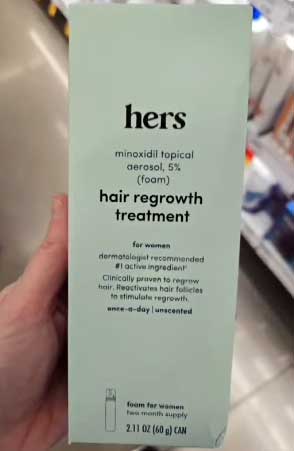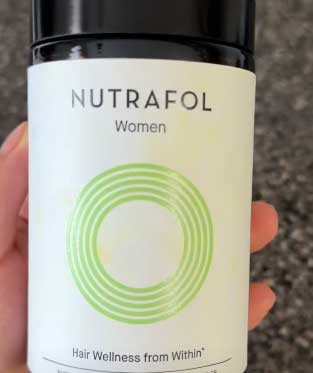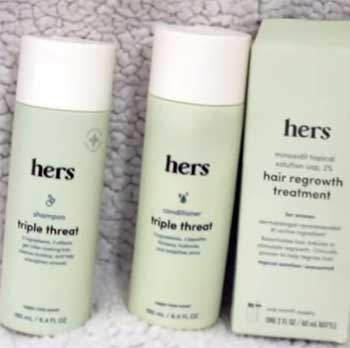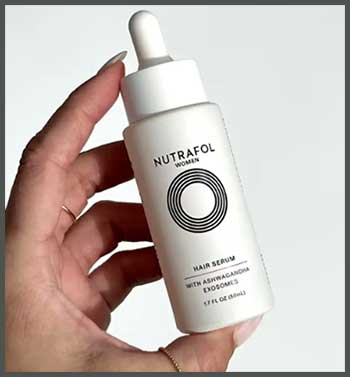Hair thinning hit me like a ton of bricks in my late 30s. I noticed more strands in my brush, a wider part, and a scalp that seemed to peek through more than it used to.
Determined to find a solution, I explored two popular options: Nutrafol and Hers hair growth supplements. In this article, I’ll share my real-user experience, break down their pros and cons, and compare their key features to help you decide which might work for your hair goals.
Let’s get to the root of it.
A Brief Comparison Table
| Feature | Nutrafol | Hers |
| Target Audience | Women 18-44, 45+, postpartum, men | Women, focus on prescription options |
| Key Ingredients | Saw palmetto, ashwagandha, collagen | Minoxidil, finasteride, biotin |
| Form | Oral capsules | Oral pills, topical solutions |
| Prescription Required | No | Yes for some products |
| Time to Results | 3-6 months | 3-6 months (topical faster) |
| Price (Monthly) | $79-$88 | $30-$50 (varies by product) |
| Vegan Option | Yes (Women’s Vegan) | No |
| Side Effects | Mild digestive issues | Scalp irritation, hormonal changes |
| Dermatologist Recommended | Yes, widely endorsed | Yes, for prescription products |
| Best For | Holistic, natural approach | Prescription-strength results |
My Hair Loss Wake-Up Call
I’ve always taken pride in my hair—long, wavy, and full of life. But after a stressful year and some hormonal shifts post-pregnancy, I started noticing changes. My ponytail felt thinner, and my scalp seemed more visible in photos.
It wasn’t just vanity; it was a confidence hit. I wasn’t ready to accept this as my new normal, so I began researching solutions. Nutrafol and Hers kept popping up in forums, dermatologist recommendations, and ads.
Both promised thicker, healthier hair, but their approaches seemed worlds apart. I decided to try them both, and here’s what I learned.
Understanding Nutrafol: A Holistic Heavyweight
Nutrafol markets itself as a “whole-body wellness” solution, targeting hair loss from multiple angles—stress, hormones, nutrition, and more. It’s a nutraceutical, meaning it’s a supplement packed with natural ingredients designed to support overall health, not just your hair.
I started with Nutrafol Women, formulated for women aged 18-44, since I fit that demographic.
Key Features of Nutrafol

The ingredient list reads like a health food store’s dream: saw palmetto to block DHT (a hormone linked to hair loss), ashwagandha to manage stress, and marine collagen for hair strength.
It also includes biotin, vitamin C, and curcumin, all aimed at reducing inflammation and boosting hair growth.
I took four capsules daily, which felt like a commitment, but they were easy to swallow.
Nutrafol offers tailored formulas—Women’s Vegan, Postpartum, Women’s Balance (for 45+), and Men’s—making it versatile for different life stages.
What stood out was the science behind it. Nutrafol cites clinical studies showing 80% of women saw improved hair growth after six months.
I liked that it’s drug-free, non-GMO, and gluten-free, aligning with my preference for natural products.
The brand also offers a Hair Wellness Quiz to personalize your regimen, which felt like a thoughtful touch.
Pros of Nutrafol
- Holistic Approach: It tackles multiple causes of hair loss, from stress to hormonal imbalances, which resonated with my complex triggers.
- Natural Ingredients: No harsh chemicals, and the vegan option was a plus for my plant-based friends.
- Dermatologist Backing: It’s the #1 dermatologist-recommended hair growth supplement, per a 2024 survey.
- Minimal Side Effects: I experienced slight bloating initially, but it faded after a week.
- Customizable: Formulas for different ages, genders, and lifestyles make it inclusive.
Cons of Nutrafol
- Pricey: At $79-$88 per month, it’s a significant investment. I winced at the cost, especially since results take months.
- Slow Results: I noticed less shedding after three months, but fuller hair took closer to six.
- Pill Burden: Four capsules a day felt excessive compared to other supplements.
- Not for Everyone: Pregnant women (except Postpartum formula) and those on blood thinners should avoid it.
- Fish Allergy Concern: Most formulas contain marine collagen, a no-go for fish allergies or strict vegans.
My Nutrafol Experience
After three months, I saw less hair in my shower drain, which was a relief. By month six, my hair felt thicker, and my stylist commented on new growth around my hairline.
The stress-reducing ingredients, like ashwagandha, seemed to help my overall mood, a welcome side benefit. However, the cost and daily pill routine tested my patience. I also worried about long-term selenium intake, as some studies suggest high doses could pose risks.
Still, Nutrafol felt like a solid, natural choice for someone like me who wanted to avoid prescriptions.
Exploring Hers: Prescription Powerhouse

Hers is a telehealth platform offering a range of women’s health products, including hair loss treatments.
Unlike Nutrafol’s supplement-only approach, Hers combines prescription medications like minoxidil and finasteride with over-the-counter supplements.
I tried their Hair Regrowth Treatment (topical minoxidil) and their Hair Growth Supplement, curious about how a prescription-backed option would compare.
Key Features of Hers
Hers’ star player is minoxidil, a topical solution applied to the scalp to stimulate hair follicles.
It’s FDA-approved for hair loss, which gave me confidence in its efficacy.
Their oral supplement contains biotin, vitamins A and C, and horsetail extract to support hair health. Finasteride, available for postmenopausal women, targets DHT like Nutrafol’s saw palmetto but with stronger, prescription-grade effects.
Hers requires an online consultation for prescriptions, which was quick and discreet.
The supplement is a single daily pill, and the topical minoxidil comes in a dropper or spray. Hers also offers shampoos and conditioners, creating a full haircare ecosystem.
Pricing is more budget-friendly, with supplements at $30-$50 monthly and minoxidil around $15-$30.
Pros of Hers
- Proven Efficacy: Minoxidil is backed by decades of research, with 60% of women seeing regrowth in 3-6 months.
- Affordable: Compared to Nutrafol, Hers’ products are easier on the wallet.
- Fast-Acting Topical: I noticed new hair sprouts within two months with minoxidil, faster than Nutrafol.
- Convenient: The telehealth platform makes getting prescriptions hassle-free.
- Comprehensive Line: Combining supplements, topicals, and haircare products offers a multi-pronged approach.
Cons of Hers
- Side Effects: Minoxidil caused mild scalp irritation, and finasteride carries risks like hormonal changes.
- Prescription Barrier: Not everyone wants to deal with doctor consultations or medications.
- No Vegan Supplement: The oral supplement isn’t vegan-friendly, unlike Nutrafol’s option.
- Topical Commitment: Applying minoxidil daily was messier and more time-consuming than popping pills.
- Limited Customization: Hers focuses on women, with less tailoring for specific life stages compared to Nutrafol.
My Hers Experience
The minoxidil was a game-changer. Within two months, I saw baby hairs along my temples, and by month four, my part looked less sparse. The supplement was fine but felt less impactful than Nutrafol’s robust formula.
However, the scalp irritation from minoxidil was annoying, and I didn’t love the greasy residue. The telehealth process was smooth, but I felt uneasy about potential side effects from finasteride, so I skipped it. Hers worked faster, but I missed Nutrafol’s natural, holistic vibe.
Breaking Down The Differences of Nutrafol And Hers
Choosing between Nutrafol and Hers depends on your priorities, lifestyle, and comfort with medications. Here’s how they stack up across key factors.
- Ingredients and Approach

Nutrafol’s strength is its natural, multi-targeted formula.
Ingredients like saw palmetto and ashwagandha address DHT and stress without synthetic drugs.
It’s ideal if you prefer a gentle, holistic path.
Hers, however, leans on minoxidil’s proven track record and offers finasteride for more aggressive DHT blocking.
The supplement is simpler, focusing on basic vitamins, but it’s secondary to the prescription products.
If you want fast, clinically validated results and don’t mind medications, Hers has the edge.
- Speed and Results
Hers’ topical minoxidil outpaced Nutrafol in my experience. I saw visible regrowth in two months, while Nutrafol took three to six months for noticeable changes.
Clinical data supports this: minoxidil users often see results by 12-24 weeks, while Nutrafol’s studies show 80% improvement at six months. If patience isn’t your virtue, Hers might suit you better.
- Cost and Commitment
Nutrafol’s $79-$88 monthly price tag stung, especially with no immediate results. Hers is more affordable, with supplements and minoxidil ranging from $15-$50 monthly.
However, Nutrafol’s subscription includes free naturopathic consults, adding value. Both require long-term commitment, but Hers’ lower cost makes it easier to stick with.
- Ease of Use
Swallowing four Nutrafol capsules daily was a chore, but it was less messy than applying minoxidil. Hers’ topical routine took five minutes, but I dreaded the sticky feeling.
The single-pill supplement from Hers was a breeze, but it lacked Nutrafol’s comprehensive formula. If you hate fussing with topicals, Nutrafol wins for simplicity.
- Side Effects and Safety
Nutrafol’s natural ingredients caused minimal issues—some bloating, but nothing serious. Hers’ minoxidil irritated my scalp, and finasteride’s potential hormonal effects made me cautious.
Nutrafol is safer for most, but those with fish allergies or specific medical conditions should check labels. Hers requires more caution due to prescription drugs.
- Customization and Accessibility
Nutrafol’s range of formulas—Women’s, Vegan, Postpartum, Men’s—caters to diverse needs. Hers focuses on women, with prescription products tailored for pre- and postmenopausal stages.
Nutrafol’s over-the-counter status makes it more accessible, while Hers’ telehealth platform adds a step but ensures professional oversight.
Which Worked Better For Me?

After six months with both, I leaned toward Nutrafol for its natural approach and whole-body benefits.
The reduced shedding and thicker hair were worth the wait, and I felt better overall, likely thanks to the stress-busting ingredients.
Hers’ minoxidil delivered faster regrowth, but the irritation and prescription reliance didn’t align with my preference for drug-free solutions.
That said, if you’re battling severe thinning and want quick results, Hers’ prescription products are hard to beat.
Your choice depends on your goals. If you’re like me, prioritizing natural ingredients and long-term wellness, Nutrafol’s holistic formula is a strong contender.
If you need rapid regrowth and don’t mind topicals or prescriptions, Hers is the way to go. Either way, consistency is key—hair growth takes time, and no product is a miracle cure.
Tips for Maximizing Results with Either Product

Regardless of which you choose, a few strategies can boost your success.
First, stick to the routine—missing doses or applications delays progress.
Pair your supplement with a balanced diet rich in protein, iron, and omega-3s, as hair thrives on nutrition.
Manage stress through exercise or meditation, since cortisol can sabotage growth. Avoid heat styling and harsh chemicals, which weaken strands.
Finally, consult a dermatologist to rule out underlying conditions like thyroid issues or alopecia areata.
Combining these habits with Nutrafol or Hers gave me the best outcome.
The Bigger Picture: Hair Loss and Self-Confidence
Hair loss isn’t just about aesthetics; it’s deeply personal. For me, thinning hair chipped away at my self-esteem, making me hyper-aware of my appearance.
Both Nutrafol and Hers helped restore not just my hair but also my confidence. Nutrafol’s gradual, nurturing approach felt like self-care, while Hers’ quick results gave me a much-needed boost.
Whichever you choose, know that you’re taking a step toward feeling like yourself again. Hair growth is a journey, not a race, and you’re worth the effort.
Frequently Asked Questions (FAQ)
Hers offers faster results with prescription-strength minoxidil and finasteride, but Nutrafol’s natural, holistic approach is better for those avoiding medications. It depends on your priorities—speed vs. safety.
Nutrafol is the #1 dermatologist-recommended hair growth supplement, based on a 2024 IQVIA ProVoice survey.
Minoxidil (found in Hers) is the most successful, with 60% of users seeing regrowth in 3-6 months, backed by decades of research.
Yes, clinical studies show 80% of women experienced increased hair growth after six months of Nutrafol use. Results vary, but consistency is crucial.
Conclusion: Your Hair, Your Choice
You’re standing at a crossroads, just like I was, wondering if Nutrafol or Hers will help you reclaim the thick, vibrant hair you love. I’ve shared my experience—Nutrafol’s natural, slow-but-steady wins and Hers’ fast, prescription-powered results.
Both have strengths, but your lifestyle, budget, and comfort with medications will guide your decision. Take the leap, stay consistent, and trust that you’re investing in yourself.
Whether you go holistic with Nutrafol or clinical with Hers, you’re on the path to healthier hair and a confident you. What’s your next step?
